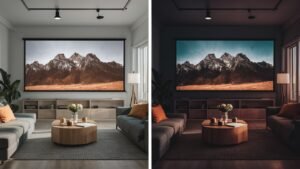A frequent problem that many projector owners have is projector burn-in, which can result in irritating problems with image quality. The last thing you want is a persistent shadow or discoloration ruining your viewing experience, whether you’re using a projector for home theater, business presentations, or educational objectives.
Everything you need to know about projector burn-in will be covered in detail in this extensive tutorial, including its definition, how it happens, and the best ways to avoid and fix it. After reading this article, you should have all the resources and information needed to make sure your projector keeps performing at its peak for many years to come.
Table of Contents
How does projector burn-in happen and what does it entail?
Image retention, another name for projector burn-in, is the phenomenon when a still image or a portion of a still image gets permanently carved onto the display. This problem usually occurs when a projector is used to show the same pattern or image for an extended amount of time. This causes the pixels in that area to “burn in,” leaving a ghostly imprint that is visible even when the projector is showing other content.
How Burn-In Occurs:
Uneven pixel use on the projector’s display is the main cause of burn-in. Certain pixels begin to wear out differently than the surrounding pixels when they are exposed to static images for an extended period of time, especially those with high contrast. Burn-in, the term for the visible darkening or shadow on the screen caused by this differential wear, is prevalent.
For instance, if a projector is used to show a static logo in the corner of the screen for extended periods of time, burn-in may occur in that area, leaving the logo as a faint but permanent shadow that is visible even when other information is displayed.
Impact on Image Quality:
Burn-in can have a major negative effect on the quality of images. Distinctive shadows or discolored areas caused by burn-in might diminish the overall viewing experience. Severe instances may cause portions of the image to become totally unreadable, particularly in high contrast regions where the burn-in is most obvious. In professional contexts, where visual sharpness is crucial, this can be very problematic.

Can Projector Burn-In Be Fixed?
How can I fix projector burn-in? This is one of the most common questions projector owners have. What kind of projector you’re using and how bad the burn-in are the two things that determine this. Let’s look at the different possibilities.
Identifying Burn-In:
It’s important to know for sure if your projector has burn-in before you try any problems fixes. A dark spot on the screen caused by too much heat, dirt on the lens, or dead pixels are some of the things that people often mistake for burn-in. Throw a solid color (like blue or white) onto a screen and look for any spots or ghost pictures. This is an easy way to check for burn-in. Most likely, burn-in is to blame if these are present.
Temporary vs. Permanent Burn-In:
Burn-in can be either temporary or permanent. Sometimes pixels get temporary burn-in, which is also called image persistence, when they are overworked but not yet forever damaged. In this case, some methods can sometimes be used to reverse or lessen the burn-in. Permanent burn-in, in contrast, means that the pixels have been damaged forever. It may be possible to make it less noticeable, but it’s usually not possible to fix it fully.
DIY Fixes for Projector Burn-In:
1. Screen Saver Techniques:
One easy way to treat mild burn-in is to run dynamic content for a few hours, like a screen saver with moving pictures. This might help spread the wear out more evenly across the pixels, which might make the burn-in less noticeable. For this reason, screen savers that switch between dark and light images work especially well.
2. Image Shifting:
Some new projectors have a feature called “image shifting” that moves the whole picture a little every so often. This small movement keeps any one pixel from being used too much, which lowers the risk of burn-in. Turning this feature on can be a good way to keep your projector from getting burn-in and can also help with light burn-in.
3. Regular Maintenance:
If you clean and maintain your projector regularly, dust and other particles will not be able to build up on the lens or internal parts, which can make burn-in worse. Making sure your projector has enough air flow and isn’t getting too hot can also help stop the conditions that cause burn-in.
When to Get Professional Help:
You might need to see a professional worker if the burn-in is bad or if you’ve tried to fix it yourself and failed. They can look at the damage and offer more advanced ways to fix it, like replacing the bulb, the DLP chip, or other parts that could be causing the problem.
Preventing Projector Burn-In
When it comes to projector burn-in, prevention is always better than treatment. Here’s how to keep your projector in peak shape and avoid burn-in completely.
Optimal Usage Practices:
1. Avoid Static Images:
The best defence against burn-in is to stay away from static image displays for long periods. To reduce the risk, think about dimming the brightness or introducing motion to the screen if you must display static content.
2. Brightness Settings:
Excessive brightness on your projector over an extended period of time can hasten pixel deterioration and cause burn-in. To avoid overstretching the projector, make sure the brightness settings are adjusted to a suitable level for your surroundings.
3. Breaks Between Use:
Give your projector a break! Burn-in can occur more frequently when a projector is used continuously without being given time to cool down. Make it a practice to turn off your projector so it can cool down after extended viewing periods.
Routine Maintenance:
The best way to avoid projector burn-in is to do routine maintenance. This comprises:
- Cleaning: To avoid dust accumulation, which can lead to overheating and exacerbate burn-in, clean the lens and filters regularly.
- Ventilation: To prevent overheating, make sure the projector is situated in a well-ventilated area. Burn-in can result from overheating, which ages the components too quickly.
- Software upgrades: Try to keep the firmware on your projector up to date. Manufacturers sometimes release upgrades that address burn-in and image retention problems.
Read More: The Ultimate Guide to Projector Maintenance in 2024
Alternative Solutions: When Burn-In Can’t Be Fixed
Sometimes the damage caused by burn-in is too great to remediate, or the expenses are too great. Here are a few options to think about.
Thinking About Replacing particular Parts:
Replacing particular parts may be a possibility if burn-in has gotten to the point where it seriously restricts your ability to use the projector. Typical components that may require replacement include:
- The Bulb: Projector bulbs have a tendency to dim with time and cause inconsistent image quality, which can make burn-in worse. If the burn-in is not too bad, changing the lightbulb might fix the problem.
- LCD Panels or DLP Chip: Replacing the LCD panels or DLP chip may be required in more complex cases, although this can be expensive.
Upgrading Your Projector:
Changing to a newer model with improved technology designed to avoid burn-in is sometimes the best course of action. In order to lessen the possibility of burn-in, modern projectors frequently include features like image-shifting, integrated screen savers, and enhanced cooling systems. In the long run, buying a new projector might be more economical, particularly if your present model is old or has seen heavy use.
Conclusion
Understanding burn-in is vital for everyone who uses a projector for entertainment, business, or education. You may avoid burn-in, reduce its effects if it does occur, as well as make sure your projector continues to deliver sharp, vibrant pictures for many years to come by using the suggestions and strategies listed in this article. The key is to take prompt action and provide your projector with regular upkeep, regardless of the severity of the burn-in or picture retention.
Frequently Asked Questions (FAQs)
Q1: What leads to projector burn-in?
Prolonged static image display or excessive brightness levels can cause burn-in, which causes the projector screen to permanently discolor.
Q2: Is burn-in reversible?
While there are times when burn-in can be lessened using specific methods, burn-in is sometimes irreversible, particularly in cases of severe burn-in.
Q3: How can I prevent burn-in on my projector?
Avoiding static images, modifying brightness settings, and making sure that maintenance and ventilation are done correctly are all part of preventing burn-in.
Q4: Is a projector with significant burn-in worth fixing?
This is contingent upon the degree of burn-in and the expense of repairs. Changing to a new projector could be more cost-effective in some circumstances.
Q5: How frequently should I clean my projector to avoid problems like burn-in?
It is advised to clean frequently, ideally every few months, to avoid dust accumulation that can cause burn-in and overheating.




